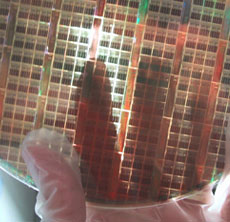 |
|
Photo courtesy of IBM |
Labs and industry perfect 3D chip
High-tech businesses must constantly innovate or become obsolete. But when it comes to investing in new machinery and adopting new techniques, industry can be timid, says Bob Patti, chief technical officer of Tezzaron Semiconductor.
That's where research laboratories come in. Freed from market constraints, they can afford to break new ground and demonstrate that an innovative technology works. Companies can then adapt the technology, with minimal risk, for products with mass appeal.
In this case, Fermilab has recruited more than a dozen other research labs to work with Tezzaron to develop three-dimensional computer chips.
Fermilab has been working on 3D chips since 2006 as a way to make detectors that track particles coming out of high-energy collisions more precise and compact. Now it hopes to use industry's economy of scale to accelerate the production of the new chips.
Tezzaron benefits by sharing the cost of developing new prototypes and by demonstrating to potential customers that the 3D chip is cost-effective.
Once companies see others out there using a new technology, "they feel more comfortable placing bets on it," Patti says.
For almost a decade, Tezzaron has been developing 3D chip technology to give devices such as cameras and cell phones more memory and to improve the speed and energy efficiency of information processors.
Traditional integrated circuits are flat and connect at the edges like tiles. "They were like one-story buildings built on different lots," Patti says.
In the late 90s, companies began stacking the flat chips and connecting them at the edges like buildings with multiple stories—but with no way for electrical currents to move up and down, aside from outdoor fire escapes.
In today's 3D circuits, wires run directly from one layer to the next, a shorter distance that uses 40 percent less energy.
"We're installing elevators," says Gretchen Patti, a member of Tezzaron's technical staff.
Working with research laboratories pushes the company to improve its product, she says.
"If you're working with a client who is not afraid to push the envelope," she says, "you're more likely to come up with something better than expected."
Kathryn Grim
Click here to download the pdf version of this article.






